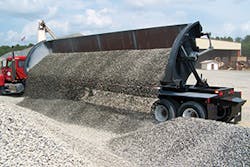A side dump trailer offers a great deal of versatility, points out Nick Jensen, president of the Thurston Manufacturing Co.’s side dump trailers can haul anything from rip-rap to demolition materials . . . even trees, he adds.
“They’re fantastic for hauling dirt in to road construction projects where you have to dump over a barrier,” says Jensen.
Thurston has increased capacity in its side dump trailers through adding to its line the Super Cube Dump Body, offering 37-foot capacity in contrast to the company’s standard 34-foot dump body, which the company still offers.
The newer model increases the capacity to 26.1 yards “and that’s water-level—not heaped—full,” notes Jensen, adding that capacity can increase to 42 yards when a high side kit is placed on it.
A side dump trailer offers a great deal of versatility, points out Nick Jensen, president of the Thurston Manufacturing Co.’s side dump trailers can haul anything from rip-rap to demolition materials . . . even trees, he adds. “They’re fantastic for hauling dirt in to road construction projects where you have to dump over a barrier,” says Jensen. Thurston has increased capacity in its side dump trailers through adding to its line the Super Cube Dump Body, offering 37-foot capacity in contrast to the company’s standard 34-foot dump body, which the company still offers. The newer model increases the capacity to 26.1 yards “and that’s water-level—not heaped—full,” notes Jensen, adding that capacity can increase to 42 yards when a high side kit is placed on it. [text_ad] The dump body has a “rounded V,” which allows for dumping of materials as a half-round or a smooth dump body would, but also offers extra capacity. The dump body sits within the frame rails, offering added capacity per linear foot of dump body. That also offers a lower center of gravity while keeping the same low-loading height, adds Jensen. “We’ve gone beyond the tri-axle on that 37-foot dump body as well in the last year and a half and come up with a quad-axle and a quint-axle on that 37-foot super cube dump body,” he says. Factors to consider when choosing a material hauler include the length of the haul and the total versatility of the hauler, notes Jensen. Jensen contends “there’s nothing better than a side dump in terms of versatility. If you haul certain things in an end dump, some materials get hung up on the end gate. If you haul them in a belly dump, they can get hung up underneath the trailer.” Regarding the average distance of the load, Thurston’s Circle R side dump offers a cycle time of approximately 30 seconds. “That’s dump and retract and when you’re trying to jockey an end dumper around for example, a lot of times it will be more than a minute by the time you stop and unload and retract and go again,” says Jensen, adding that side dumps “run circles around belly dumps or end dumps” on short hauls. On longer hauls where capacity is more of a concern, contractors may want to consider whether a side dump would be the best choice or would something with higher cubes or higher capacity be a better choice, adds Jensen. “You want to weigh that against what the state bridge laws are, how much you can actually haul, and how much does the material weigh that you’re putting in that dump body,” he points out. “An end dump body might have more capacity than a side dump but when you start looking at weight of material, you’re going to be hauling about the same amount.” Therefore in terms of cycle times, it may make sense to use a side dump for longer hauls as long as a contractor knows the weight of the material and how much room it’s going to take, says Jensen. Another consideration in material hauling choices is serviceability and reliability, he adds. The company’s Circle R product has non-greasable hinge points, which offers time saved from not having to grease them once or twice daily, says Jensen. “If you change them once a year or twice a year when you’re doing your yearly maintenance items, you can save a lot of time that way,” he adds. The location where materials will be unloaded is another consideration in choosing a material hauler, says Jensen. “Some places are not ideal for a side dump,” he says. “Maybe you’ve got a tighter area that you’ve got to dump into that an end dump would be better for. Maybe you’ve got to have the ability to switch sides, so a side dump would be better in that scenario.” A recently-added feature to the Circle R enables the driver to safely switch the side of the trailer that he’s dumping on without getting out of the cab. “It’s a time saver and a safety issue and it ties in with the tarp kit,” says Jensen. The company also added an automatic tarp lockout so if the tarp is covering the load, the trailer won’t dump. “There have been guys who’ve dumped with the tarp on,” points out Jensen.The dump body has a “rounded V,” which allows for dumping of materials as a half-round or a smooth dump body would, but also offers extra capacity. The dump body sits within the frame rails, offering added capacity per linear foot of dump body.
That also offers a lower center of gravity while keeping the same low-loading height, adds Jensen.
“We’ve gone beyond the tri-axle on that 37-foot dump body as well in the last year and a half and come up with a quad-axle and a quint-axle on that 37-foot super cube dump body,” he says.
Factors to consider when choosing a material hauler include the length of the haul and the total versatility of the hauler, notes Jensen.
Jensen contends “there’s nothing better than a side dump in terms of versatility. If you haul certain things in an end dump, some materials get hung up on the end gate. If you haul them in a belly dump, they can get hung up underneath the trailer.”
Regarding the average distance of the load, Thurston’s Circle R side dump offers a cycle time of approximately 30 seconds.
“That’s dump and retract and when you’re trying to jockey an end dumper around for example, a lot of times it will be more than a minute by the time you stop and unload and retract and go again,” says Jensen, adding that side dumps “run circles around belly dumps or end dumps” on short hauls.
On longer hauls where capacity is more of a concern, contractors may want to consider whether a side dump would be the best choice or would something with higher cubes or higher capacity be a better choice, adds Jensen.
“You want to weigh that against what the state bridge laws are, how much you can actually haul, and how much does the material weigh that you’re putting in that dump body,” he points out. “An end dump body might have more capacity than a side dump but when you start looking at weight of material, you’re going to be hauling about the same amount.”
Therefore in terms of cycle times, it may make sense to use a side dump for longer hauls as long as a contractor knows the weight of the material and how much room it’s going to take, says Jensen.
Another consideration in material hauling choices is serviceability and reliability, he adds.
The company’s Circle R product has non-greasable hinge points, which offers time saved from not having to grease them once or twice daily, says Jensen.
“If you change them once a year or twice a year when you’re doing your yearly maintenance items, you can save a lot of time that way,” he adds.
The location where materials will be unloaded is another consideration in choosing a material hauler, says Jensen.
“Some places are not ideal for a side dump,” he says. “Maybe you’ve got a tighter area that you’ve got to dump into that an end dump would be better for. Maybe you’ve got to have the ability to switch sides, so a side dump would be better in that scenario.”
A recently-added feature to the Circle R enables the driver to safely switch the side of the trailer that he’s dumping on without getting out of the cab.
“It’s a time saver and a safety issue and it ties in with the tarp kit,” says Jensen. The company also added an automatic tarp lockout so if the tarp is covering the load, the trailer won’t dump.
“There have been guys who’ve dumped with the tarp on,” points out Jensen.






